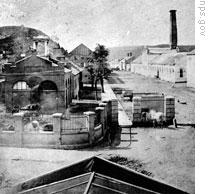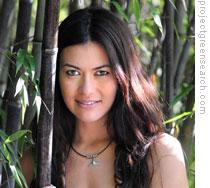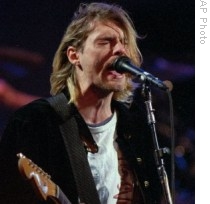2009-11-5
HOST:
Welcome to AMERICAN MOSAIC in VOA Special English.
(MUSIC)
I'm Doug Johnson. This week on our program:
A competition to find a spokesmodel for Mother Earth ...
And a question from Russia about Kurt Cobain and the band that he led, Nirvana.
But first, a report on a town marking the one hundred fiftieth anniversary of an anti-slavery rebellion.
(MUSIC)
HOST:
Harpers Ferry is a small town in West Virginia. It is in a beautiful area of the Blue Ridge Mountains where the Potomac and Shenandoah rivers come together. Also, the states of West Virginia, Virginia and Maryland meet in the area. The Appalachian Trail runs through Harpers Ferry. The town has shops, restaurants and a National Historical Park. Many people visit Harpers Ferry to see a town that looks the same as it did more than one hundred fifty years ago. This year it is celebrating the anniversary of an important historical event. Mario Ritter has more.
MARIO RITTER:
VOA reporter Susan Logue visited Harpers Ferry recently. She spoke to Park Ranger David Fox. He says the town was very different in eighteen fifty-nine.
He says Harpers Ferry was a noisy, dirty, polluted industrial city in what was then Virginia, the largest slave state in America.
It was also home to the United States Armory and Arsenal, one of only two in the country. Weapons for the army were made and stored there.
John Brown was an important person in the history of Harpers Ferry. He was an abolitionist. He wanted to end slavery in the United States.
 |
| The Armory at Harpers Ferry, left |
John Brown and his men seized the arsenal and its one hundred thousand weapons. They also seized the nearby arms factory and a railroad bridge. A battle followed, first involving local armed groups and then the United States Marines. Eighteen people were killed. After thirty-six hours, Brown was captured in the building that served as the fire engine and guard house. It is the only armory building still standing. It is now known as John Brown's Fort.
Park Ranger David Fox says this building has different meanings to different people.
DAVID FOX: "To some people this building is the scene of a crime, where a murderer and a traitor was captured and brought to justice. To others, this monument is nothing less than a monument to freedom on a battlefield."
 |
| U.S. Marines attack the engine house at Harpers Ferry |
Last month, the Harpers Ferry National Historical Park and other partners held many programs observing the one hundred fiftieth anniversary of John Brown's raid. There were talks, living history re-enactments, special tours, and musical and dramatic events. Visitors to Harpers Ferry can learn about America's history as it brings the past to life.
(MUSIC)
HOST:
The United States has many famous and beautiful women who model clothing and represent companies or causes. This weekend, Project Green Search will announce its selection of a new model for the environmental "Green Revolution." Barbara Klein has more.
(SOUND)
BARBARA KLEIN:
This modeling competition is about much more than beauty. Project Green Search is looking for young women who are also concerned about the environment, animal welfare, fair trade and human rights. The judges have chosen ten finalists. We would like to tell you about three of them.
 |
| Leilani Munter |
Miz Munter purchases half a hectare of rainforest for every race she drives. She demands that her racing sponsors be eco-friendly and she is pushing her sport to become more eco-friendly too.
Zion Francis was a civil engineer and is now a model and actress. She studied sustainable engineering methods in France. She has been working to support the Green Revolution in the United States.
Miz Francis has volunteered for social and environmental organizations. They include Engineers for a Sustainable World, the Sustainable Food Center in Austin, Texas, and the Forest Service in California. Zion Francis says green living is honoring your position as a human, a citizen and a consumer.
Vanessa Meier is interested in the animal food production industry. She says that raising animals for food is responsible for the release of more greenhouse gases than all forms of transportation combined. Miz Meier is working to change this.
She does not eat animals or animal products. She says any discussion about improving the environment must include a discussion about changing the animal food production industry and changing people's diets.
(MUSIC)
HOST:
Our listener question this week comes from Russia. Alex Shestakov wants to know about Kurt Cobain and his band, Nirvana.
 |
| Kurt Cobain |
Grunge songs often express feelings of hopelessness, helplessness and dark humor. The song "Lithium" is a good example. It is from the album that brought Nirvana huge fame, "Nevermind."
(MUSIC)
Many critics would say Kurt Cobain was one of the greatest rock and roll artists of his time. But his personal story was tragic.
Cobain had a serious case of scoliosis, or curvature of the spine, as a child. He also suffered from severe stomach pain his whole life. And he struggled with depression.
Cobain became dependent on the powerful drug heroin. He also abused other pain-killing drugs and alcohol. Cobain reportedly was always insecure, questioning his worth as a person. He once wrote: "I hate myself and I want to die."
In nineteen ninety-two Kurt Cobain married musician Courtney Love and the couple had a baby girl. Cobain appeared much happier than he had ever been. The next year Nirvana released its final studio album. "In Utero" entered Billboard Magazine's top two hundred albums chart in the number one position. "Heart-Shaped Box" was one of the album's hit singles.
(MUSIC)
Sadly, Kurt Cobain could not break his heroin addiction or win his battle with depression. In April of nineteen ninety-four the musician shot and killed himself at his home in Seattle, Washington. He was only twenty-seven. Thousands of fans attended his memorial service. We leave you with Kurt Cobain singing "All Apologies" from the Nirvana album, "In Utero."
(MUSIC)
HOST:
I'm Doug Johnson. Our program was written by June Simms, Shelley Gollust and Caty Weaver who was also our producer.
Join us again next week for AMERICAN MOSAIC, VOA's radio magazine in Special English.